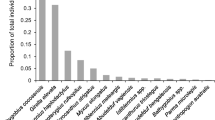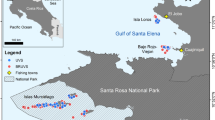Abstract
Locally based and volunteer-based monitoring approaches have recently received greater attention as a cost-effective way to collect data on the environment and/or involve stakeholders in management. The present study compared three monitoring methods based on an underwater visual census (UVC) of reef fish in a customary area in Navakavu (Viti Levu Island, Fiji). Two non-scientific approaches involved (1) snorkellers from the village using vernacular names for five local focal fish taxa and (2) non-resident volunteers using the Reef Check target list of fish for the Indo-Pacific (nine focal taxa). These approaches were cross-checked with a comprehensive scientific survey (all fish recorded at the species level across 12 families). The three methods were compared in terms of accuracy, precision, and ability to highlight changes in fish abundance between the community-managed no-take zone (NTZ) and the fished area. We found that scientific and volunteer-based data were consistent in terms of means and variance of abundance estimates but that Reef Check focal taxa would not be suitable for monitoring the Navakavu marine area. On the contrary, the locally selected target taxa were appropriate but overestimates and imprecision were noticed in the fish counts made by the community members. Differences in abundance of two major target taxa (Lethrinidae and Mullidae) between the NTZ and the harvest area were not validated by the scientific observations. Calibration of community-based UVC is thus needed especially if information from the local biological monitoring program is used to guide management actions.




Similar content being viewed by others
Abbreviations
- CV:
-
Coefficient of variation
- IRD:
-
Institut de Recherche pour le Développement
- LMMA:
-
Locally managed marine area
- NTZ(s):
-
No-take zone(s)
- SD:
-
Standard deviation
- USP:
-
University of the South Pacific
- UVC:
-
Underwater visual census
References
Buckland ST, Magurran AE, Green RE et al (2005) Monitoring change in biodiversity through composite indices. Philos Trans R Soc B 360:243–254. doi:10.1098/rstb.2004.1589
Cakacaka A, Meo S, Degei M et al (2007) FLMMA site report—Navakavu 2005 & 2006. University for the South Pacific, Suva
Cheal AJ, Thompson AA (1997) Comparing visual counts of coral reef fish: implications of transect width and species selection. Mar Ecol Prog Ser 158:241–248. doi:10.3354/meps158241
Clua E, Beliaeff B, Chauvet C et al (2005) Towards multidisciplinary indicator dashboards for coral reef fisheries management. Aquat Liv Res 18:199–213. doi:10.1051/alr:2005026
Cooke AJ, Polunin NVC, Moce K (2000) Comparative assessment of stakeholder management in traditional Fijian fishing grounds. Environ Conserv 27:291–299. doi:10.1017/S0376892900000333
Danielsen F, Mendoza MM, Alviola P et al (2003) Biodiversity monitoring in developing countries: what are we trying to achieve? Oryx 37:407–409
Danielsen F, Jensen AE, Alviola PA et al (2005a) Does monitoring matter? A quantitative assessment of management decisions from locally based monitoring of protected areas. Biodivers Conserv 14:2633–2652. doi:10.1007/s10531-005-8392-z
Danielsen F, Burgess ND, Balmford A (2005b) Monitoring matters: examining the potential of locally based approaches. Biodivers Conserv 14:2507–2542. doi:10.1007/s10531-005-8375-0
Darwall WRT, Dulvy NK (1996) An evaluation of the suitability of non-specialist volunteer researchers for coral reef fish surveys. Mafia Island, Tanzania—a case study. Biol Conserv 78:223–231
Degnbol P (2005) Indicators as a means of communicating knowledge. ICES J Mar Sci 62:606–611. doi:10.1016/j.icesjms.2004.12.007
Denny CM, Babcock RC (2004) Do partial marine reserves protect reef fish assemblages? Biol Conserv 116:119–129. doi:10.1016/S0006-3207(03)00183-6
Graham NAJ, Dulvy NK, Jennings S et al (2005) Size-spectra as indicators of the effects of fishing on coral reef fish assemblages. Coral Reefs 24:118–124. doi:10.1007/s00338-004-0466-y
Hill J, Wilkinson C (2004) Methods for ecological monitoring of coral reefs. Australian Institute of Marine Science, Townsville
Hockley NJ, Jones JPG, Andriahajaina FB et al (2005) When should communities and conservationists monitor exploited resources? Biodivers Conserv 14:2795–2806. doi:10.1007/s10531-005-8416-8
Hodgson G, Hill J, Kiene W et al (2006) Reef Check instruction manual. A guide to Reef Check coral reef monitoring. Reef Check Foundation, Pacific Palisades
Jennings S (2005) Indicators to support an ecosystem approach to fisheries. Fish Fish 6:212–232. doi:10.1111/j.1467-2979.2005.00189.x
Jennings S, Polunin NVC (1996) Fishing strategies, fishery development and socioeconomics in traditionally Fijian fishing grounds. Fish Manag Ecol 3:335–347. doi:10.1046/j.1365-2400.1996.d01-155.x
Kleiber P, Maunder MN (2008) Inherent bias in using aggregate CPUE to characterize abundance of fish species assemblages. Fish Res 93:140–145. doi:10.1016/j.fishres.2008.03.013
Lang M, Baldwin C (1996) Methods and techniques of underwater research. In: Proceedings of the American Academy Underwater Science Scientific Diving Symposium, Smithsonian Institution, Washington
Maxwell D, Jennings S (2005) Power of monitoring programmes to detect decline and recovery of rare and vulnerable fish. J Appl Ecol 42:25–37. doi:10.1111/j.1365-2664.2005.01000.x
McClanahan TR, Marnane MJ, Cinner JE et al (2006) A comparison of marine protected areas and alternative approaches to coral-reef management. Curr Biol 16:1408–1413. doi:10.1016/j.cub.2006.05.062
Moller H, Berkes F, Lyver PO, Kislalioglu M (2004) Combining science and traditional ecological knowledge: monitoring populations for co-management. Ecol Soc 9:2–8
Mouillot D, Culioli JM (2002) The sample size necessary to assess changes in fish biomass—a reply. Mar Ecol (Berl) 23:11–18. doi:10.1046/j.1439-0485.2002.02768.x
Mumby PJ, Harborne AR, Raines PS et al (1995) A critical assessment of data derived from Coral Cay conservation volunteers. Bull Mar Sci 56:737–751
Neis B, Schneider DC, Felt L et al (1999) Fisheries assessment: what can be learned from interviewing resource users? Can J Fish Aquat Sci 56:1949–1963. doi:10.1139/cjfas-56-10-1949
Nicholson MD, Jennings S (2004) Testing candidate indicators to support ecosystem-based management: the power of monitoring surveys to detect temporal trends in fish community metrics. ICES J Mar Sci 61:35–42. doi:10.1016/j.icesjms.2003.09.004
Nicholson E, Ryan J, Hodgkins D (2002) Community data—where does the value lie? Assessing confidence limits of community collected water quality data. Water Sci Technol 45:193–200
Obura DO (2001) Participatory monitoring of shallow tropical marine fisheries by artisanal fishers in Diani, Kenya. Bull Mar Sci 69:777–792
Olsson P, Folke C, Berkes F (2004) Adaptative comanagement for building resilience in social–ecological systems. Environ Manag (NY) 34:75–90. doi:10.1007/s00267-003-0101-7
Pelletier D, Garcia-Charton JA, Ferraris J et al (2005) Designing indicators for assessing the effects of marine protected areas on coral reef ecosystems: a multidisciplinary standpoint. Aquat Living Resour 18:15–33. doi:10.1051/alr:2005011
Pomeroy RS, Watson LM, Parks JE et al (2005) How is your MPA doing? A methodology for evaluating the management effectiveness of marine protected areas. Ocean Coast Manag 48:485–502. doi:10.1016/j.ocecoaman.2005.05.004
Rice JC (2000) Evaluating fishery impacts using metrics of community structure. ICES J Mar Sci 57:682–688. doi:10.1006/jmsc.2000.0735
Rochet MJ, Trenkel VM (2003) Which community indicators can measure the impact of fishing? A review and proposals. Can J Fish Aquat Sci 60:86–99. doi:10.1139/f02-164
Samoilys MA, Carlos G (2000) Determining methods of underwater visual census for estimating the abundance of coral reef fishes. Environ Biol Fishes 57:289–304. doi:10.1023/A:1007679109359
Schmitt EF, Sullivan KM (1996) Analysis of a volunteer method for collecting fish presence and abundance data in the Florida Keys. Bull Mar Sci 59:404–416
Sheil D (2001) Conservation and biodiversity monitoring in the tropics: realities, priorities and distractions. Conserv Biol 15:1179–1182. doi:10.1046/j.1523-1739.2001.0150041179.x
Sheil D, Lawrence A (2004) Tropical biologists, local people and conservation: new opportunities for collaboration. Trends Ecol Evol 19:634–638. doi:10.1016/j.tree.2004.09.019
Sheil D, Wunder S (2002) The value of tropical forest to local communities: complications, caveats, and cautions. Conserv Ecol 6:9
Spelleberg I (2005) Monitoring ecological change, 2nd edn. Cambridge University Press (ed), Cambridge. ISBN: 9780521527286
Tawake A, Parks J, Radikedike P et al (2001) Harvesting clams and data involving local communities in monitoring can lead to conservation success in all sorts of unanticipated ways: a case in Fiji. Conserv Pract 2:32–35. doi:10.1111/j.1526-4629.2001.tb00020.x
Tessier E, Chabanet P, Pothin K et al (2005) Visual censuses of tropical fish aggregations on artificial reefs: slate versus video recording techniques. J Exp Mar Biol Ecol 315:17–30. doi:10.1016/j.jembe.2004.08.027
Thompson AA, Mapstone BD (2002) Intra- versus inter-annual variation in counts of reef fishes and interpretations of long-term monitoring studies. Mar Ecol Prog Ser 232:247–257. doi:10.3354/meps232247
Trenkel VM, Rochet MJ (2003) Performance of indicators derived from abundance estimates for detecting the impact of fishing on a fish community. Can J Fish Aquat Sci 60:67–85. doi:10.1139/f02-163
Uychiaoco AJ, Arceo HO, Green SJ et al (2005) Monitoring and evaluation of reef protected areas by local fishers in the Philippines: tightening the adaptive management cycle. Biodivers Conserv 14:2775–2794. doi:10.1007/s10531-005-8414-x
Webb EL, Maliao RJ, Siar SV (2004) Using local user perceptions to evaluate outcomes of protected area management in the Sagay Marine Reserve, Philippines. Environ Conserv 31:138–148. doi:10.1017/S0376892904001377
Williams ID, Walsh WJ, Tissot BN et al (2006) Impact of observers’ experience level on counts of fishes in underwater visual surveys. Mar Ecol Prog Ser 310:185–191. doi:10.3354/meps310185
Acknowledgments
This study was funded by the Coral Reef Initiative for the South Pacific (CRISP Program—www.crisponline.net). The authors thank B. Aalbersberg, J. Comley, D. Kaur, E. Lovell, C. Morris, L. Tamata, R. Simpson, and R. Vave from USP for their assistance in planning and conducting the survey. Thanks to H. Sykes for the Reef Check material. We would also like to thank F. Isimeli from the Mamanuca Environmental Society, and H. Rossini from Coral Cay Conservation for the fish visual census. We are also grateful to the fishermen and villagers from yavusa Navakavu and Muaivuso village for their welcome and participation in the fieldwork. We thank J. Ferraris and two anonymous reviewers for providing helpful comments on the original manuscript.
Author information
Authors and Affiliations
Corresponding author
Rights and permissions
About this article
Cite this article
Léopold, M., Cakacaka, A., Meo, S. et al. Evaluation of the effectiveness of three underwater reef fish monitoring methods in Fiji. Biodivers Conserv 18, 3367–3382 (2009). https://doi.org/10.1007/s10531-009-9646-y
Received:
Accepted:
Published:
Issue Date:
DOI: https://doi.org/10.1007/s10531-009-9646-y




